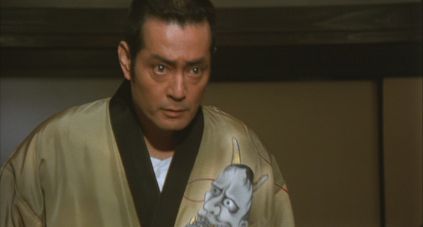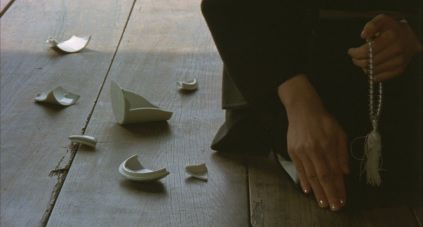« Coffee Break | Main | Ichi »
January 05, 2010
Onimasa: A Japanese Godfather

Kiryuin Hanako no Shogai
Hideo Gosha - 1982
AnimEigo Region 1 DVD
Early in Onimasa, the young girl who has just be adopted by the neighborhood gangster boss, insists on going to school. Her new father declares that formal education just confuses girls, and instead takes her to a dog fight. The scene of the dog fight sums up the dog-eat-dog viewpoint of Masagoro Kiryuin, also known as Onimasa. That scene also reverberates in a later scene when Onimasa is referred to as the pet dog of a shady businessman who uses yakuza to enforce his will. In the final scene, the barking of the vicious Japanese mastiffs is heard during a duel when Onimasa faces a rival gang. The use of dogs in the film might be obvious, but Gosha keeps any symbolism here from being heavy handed.
The original Japanese title translates as "The Life of Hanako Kiryuin. The film is more about the adopted daughter, Matsue, and her relationship with her adopted family. Even though Tatsuya Nakadai is top billed, to approach this film as primarily being about the character in the internationally used title, or as a genre film, would be a mistake. There are no extended palms, or scenes of gambling, and the one time someone performs the ritual of amputating their pinky is offscreen. Like Gosha's film, The Geisha, Onimasa is based on a novel by Tomiko Miyao. The similarity between the two films, and presumably the novels, is a look at family structures based more on professional relationships, oaths of loyalty, or monetary exchange, and less on biology. The time period for Onimasa runs from 1918 to 1940, with women and children primarily valued as commodities. The concept of people as a form of commodity is also expressed when Onimasa decides to change how his family makes money, with some half-baked ideas for unionization, exploiting superficial understanding between labor and capital, following the request of his boss to curb two union organizers. The two strains of tension are between increasingly outmoded ways of life as Japan becomes more industrialized, and Matsue's torn loyalty between the parents that adopted her, and her own need to assert her independence and intellectual abilities. The original title of the film can be viewed as ironic, as Hanako's death provides the bookends for the main narrative, which is an extended flashback of Matsue's memory of her life with the Kiryuin family.

The various narrative threads primarily revolve around Onimasa's relationship with women. His wife, Uta, is the daughter of his boss, Suda. Onimasa has two mistresses that are kept in the house, who formally ask permission of Uta before going to bed with Onimasa. A third mistress, Otsura, is taken as a form of payment from a rival gang leader. Otsura is the mother of Hanaka, a pampered young woman neither as intelligent or as attractive as Matsue. Hanaka also reveals herself to be less filial towards her father than Matsue, in spite of Onimasa's periodic abusive behavior towards his adopted daughter. Onimasa's family makes most of its money through prostitution. A common theme in Gosha's films is how sex is used for barter.
Of the handful of Gosha films I have seen, Onimasa is the least stylized. To some extent, some of the first shots when the young Matsue is introduced to the Kiryuin house and its residents, are filmed from low angles suggesting the point of view of a child. Generally speaking, the use of dramatic camera angles or color is eschewed, with Gosha's more interested in a more straightforward, naturalistic story telling. The unusual sequence would be of Onimasa's wife, Uta remembering the courtship by Onimasa, the dream of a woman fast approaching death from typhus. While the final swordfight between rival yakuza is in itself not unusual, Gosha has the scene take place primarily on a bridge, amidst heavy wind, on a bridge illuminated by two swaying strings of lightbulbs.
Onimasa received a very limited release in the U.S. in 1985. From the New York Times' Vincent Canby: "When it's almost tolerable, Onimasa recalls the the kind of excesses over which Luchino Visconti triumphed in Rocco and His Brothers and 'The Damned, but which defeated him in Ludwig." Lest anyone get the wrong idea, unlike Visconti's films, the men in Gosha's films are all unabashedly heterosexual. As for excesses, Onimasa is quite restrained compared to Goyokin with its references in both style and content to Sergio Leone and Alfred Hitchcock. That there is limited English language material on both Hideo Gosha and Tomiko Miyao is enough to suggest that a more complete understanding of this film by non-Japanese critics is essential.

Posted by Peter Nellhaus at January 5, 2010 12:25 AM
Comments
This sounds really compelling and I love that last still shot you posted.
p.s. I've given you some silly blogger award: http://cinebeats.blogsome.com/2010/01/10/blogger-awards-2/
Posted by: Kimberly Lindbergs at January 10, 2010 06:30 PM
